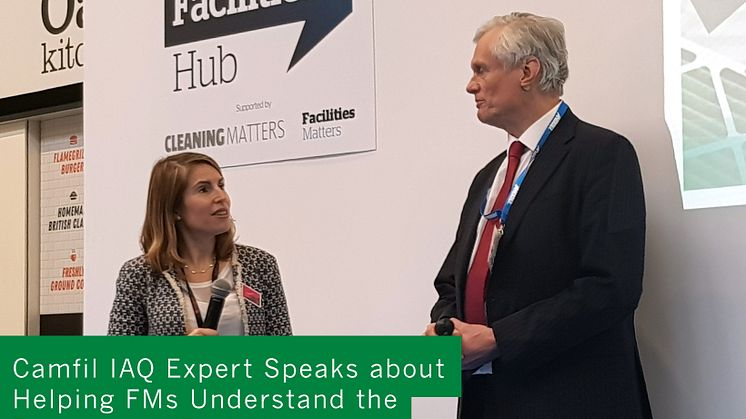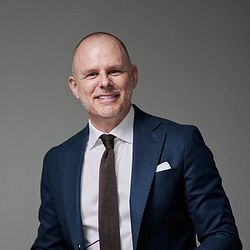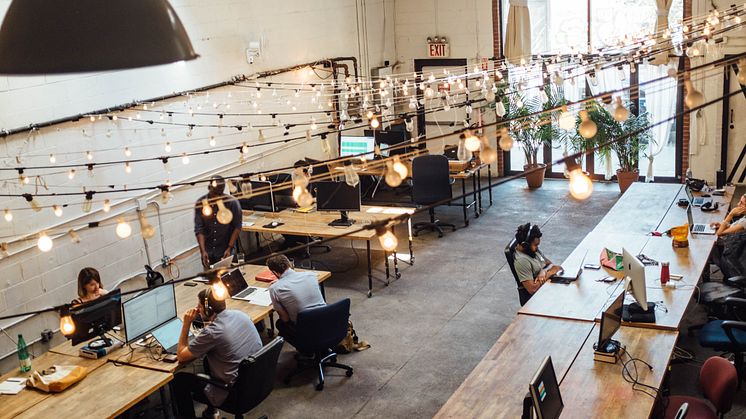
Press release -
Camfil IAQ Expert Speaks about Helping FMs Understand the Dangers of ‘Bad Air’
Camfil’s Indoor Air Quality expert, Peter Dyment in the United Kingdom, took to the stage at the Facilities Event on the 11th April, to explain how FMs can combat poor IAQ in their buildings; focusing on the dangers of the smallest particulate matter - PM1 and below.
With the majority of our workplaces in polluted city centres, ensuring the inside of these buildings are safe havens is essential – particularly as many of us spend around 90% of our lives indoors. Dyment explained the potential risks posed primarily from traffic fumes, including NOx, SOx and particulate matter. In locations with high concentrations of these elements opening a window is not a safe way to ventilate a building.
He also made the point that pollutants don’t just come from the outside in. Carpets, paints, cleaning fluids, photo copiers and even people release damaging substances into the air, including Volatile Organic Compounds (VOCs) and Aldehydes.
Invisible dangers
The problem is that we can’t see these dangers – in the past pollution was visible, with large particulates viewed as a smog. Nowadays the majority of pollution is invisible, meaning it poses more of a risk as the main composition is the smallest of particles. Unstoppable by our bodies natural defences, PM1 and below can get inside our blood stream, respiratory and nervous systems. These particles can even get into our brains and have been linked to Alzheimer’s.
In highly polluted areas we inhale 25 million particles with each breathe, not to mention combustion gases such as NOx.
Make buildings safe
Making our buildings safe, however, is easier than ever before thanks to high grade levels of HEPA and molecular filtration which stop PM1, and more effective, user friendly standards, designed to help specifiers and FMS choose the best solutions for their particular application.
By using all of the available standards and guidelines…
- BS CEN 16798-3 - IAQ filter requirements
- BS CEN ISO16890 - Particle filter testing
- BS CEN ISO 10121-2 - Molecular filter testing
- Eurovent - supply filter requirements
- World Health Organisation (WHO) guidelines on air pollution exposure limits
The right air filtration scheme can be chosen – of particular importance in highly populated buildings, such as large offices, schools and hospitals.
Camfil offers a range of solutions, from concealed fan cylinder units housed inside Air Handling Units to standalone ‘plug and play’ air purification systems suitable for use in our homes.
The good news is that indoor air can be fixed. We need to take the risks posed by poor IAQ seriously and do everything it takes to keep occupants safe.
Taking place from the 9th-11th April at the NEC in Birmingham, The Facilities Event exhibition and seminar conference is a key meeting place for the UK’s FM and workplace industry.

PETER DYMENT / Technical Manager, Camfil
With 35 year's experience in the air movement sector, Peter is an expert on Indoor Air Quality (IAQ) and energy in buildings. A well-known voice in the world of IAQ related issues, Peter is also an advisor to Clean Air London (CAL). Most recently, he has provided guidance used in support of drafting the Clean Air (Human Rights) Bill which is currently making its way through parliament. He also sits on a number of technical committees, including ISO, CEN and BSi, helping draft legislation, guidelines and codes of practice.
Topics
Categories
For more than half a century, Camfil has been helping people breathe cleaner air. As a leading manufacturer of premium clean air solutions, we provide commercial and industrial systems for air filtration and air pollution control that improve worker and equipment productivity, minimize energy use, and benefit human health and the environment. We firmly believe that the best solutions for our customers are the best solutions for our planet, too. That’s why every step of the way – from design to delivery and across the product life cycle – we consider the impact of what we do on people and on the world around us. Through a fresh approach to problem-solving, innovative design, precise process control and a strong customer focus we aim to conserve more, use less and find better ways – so we can all breathe easier.
The Camfil Group is headquartered in Stockholm, Sweden, and has 30 manufacturing sites, six R&D centres, local sales offices in 26 countries, and 4,480 employees and growing. We proudly serve and support customers in a wide variety of industries and in communities across the world. To discover how Camfil can help you to protect people, processes and the environment, visit us at www.camfil.com.




